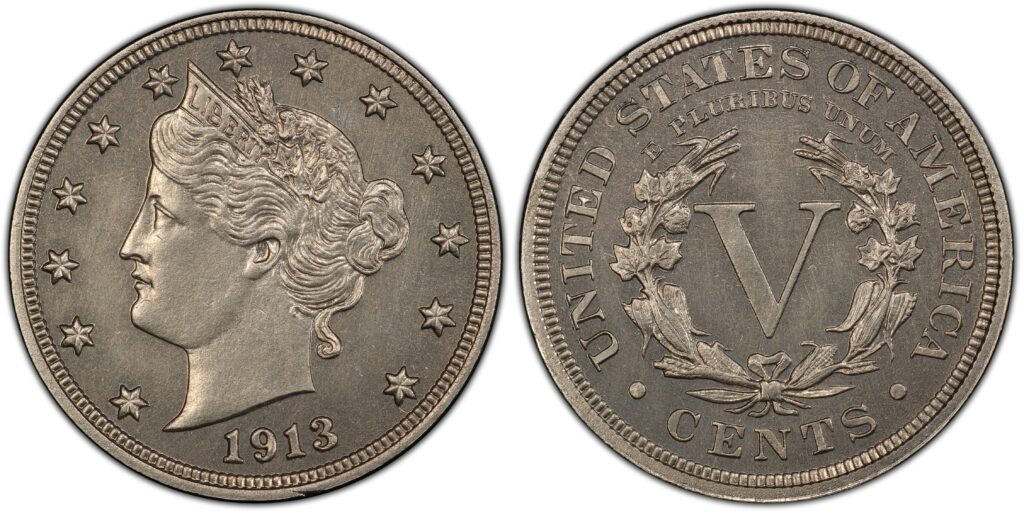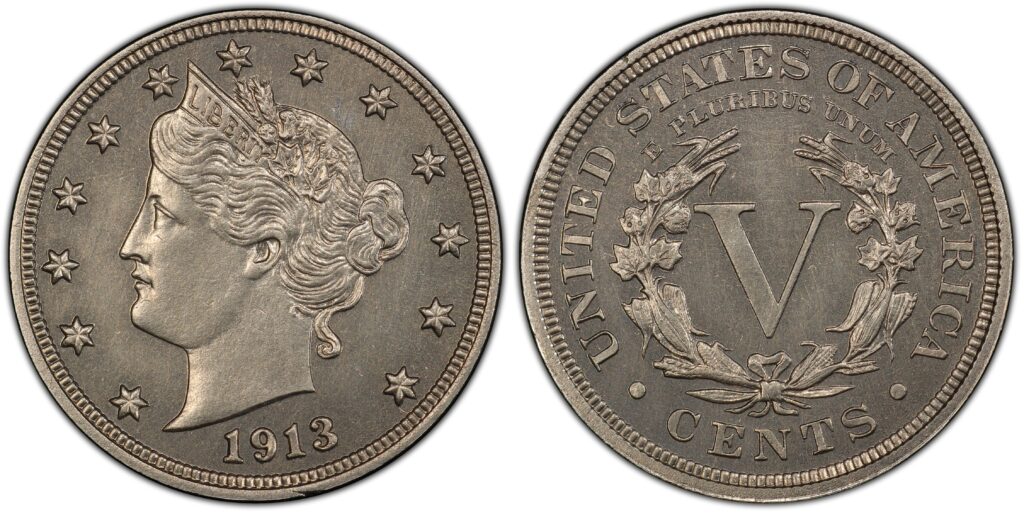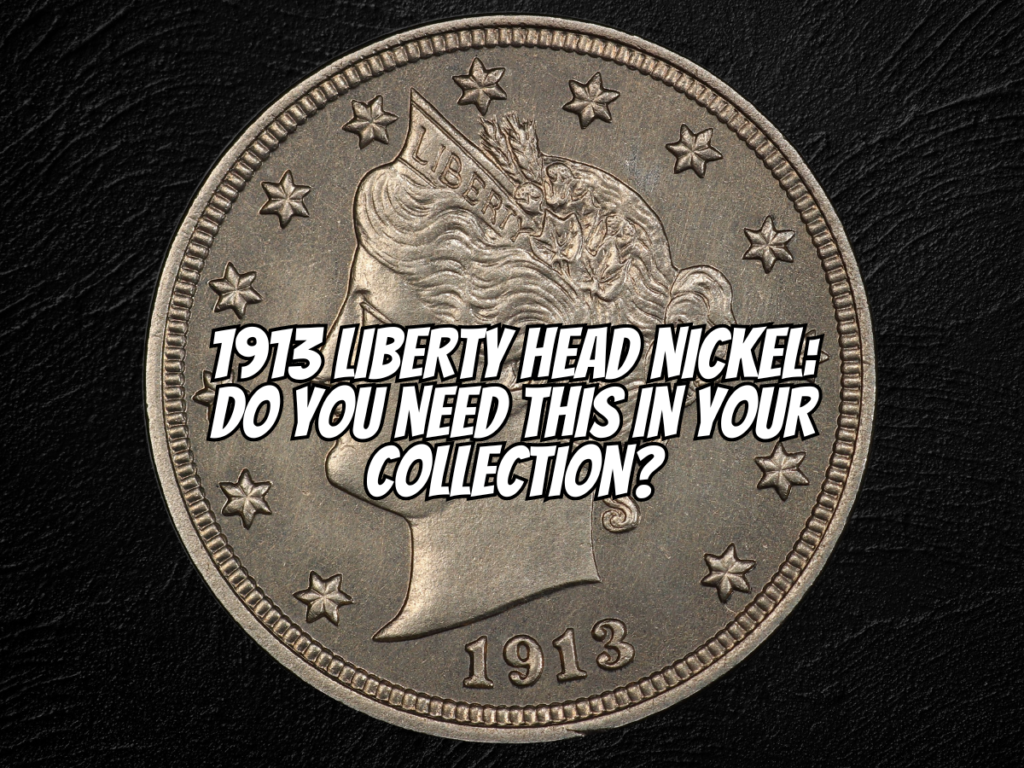The 1913 Liberty Head Nickel holds a prominent place among the most valuable and eagerly sought-after coins in the realm of American numismatics.
In this article, we’ll look closer at this magnificent coin, its rich history, and its value to collectors!
Join us as we unravel the history and rarity of the 1913 Liberty Head Nickel!
Key Takeaways
1. The 1913 Liberty Head Nickel is an American five-cent piece produced in limited quantities without authorization from the United States Mint.
2. Charles E. Barber crafted this magnificent coin, and the coin’s production spanned from 1883 to 1913.
3. The scarcity of the 1913 Liberty Head Nickels is truly remarkable, with only five of these coins documented to exist. This rarity contributes significantly to their exceptional value.
History of the 1913 Liberty Head Nickel
Design and Minting Process

Debuting in 1883, the Liberty Head nickel bore the artistic touch of Charles E. Barber, the chief engraver at the United States Mint during that period.
The coin’s obverse (front) side showcased a left-facing depiction of Lady Liberty, with the word “Liberty” elegantly scripted above her visage.
A substantial Roman numeral V was featured on the reverse (back) side, symbolizing the coin’s nominal value of five cents.
1913, a peculiar occurrence occurred as the United States Mint prepared to unveil the Buffalo nickel design.
It is postulated that five Liberty Head nickels were struck that year, even though the design had officially been retired in 1912.
The precise motive behind creating these coins remains unsurprising; conjectures suggest they might have been minted as trial specimens or as a gesture of favor to a Mint employee.
Release and Public Reception

The five 1913 Liberty Head nickels were not released to the public.
Instead, they were kept by Mint officials and eventually found their way into the hands of private collectors.
The first public auction of one of these coins occurred in 1920 when a collector named Wayte Raymond sold one for $500.
Over the years, the 1913 Liberty Head nickel has become one of the most sought-after coins in the world.
Only five are known to exist and are considered among the rarest and most valuable coins. In 2018, one of these coins sold for $4.5 million at auction.
Despite the mystery surrounding their production, the 1913 Liberty Head nickels have captured the imagination of collectors and enthusiasts for over a century.
Their rarity and historical significance have made them a coveted addition to any coin collection.
Notable Features and Specifications
Material Composition

The 1913 Liberty Head Nickel is made of a copper-nickel alloy, combining 75% copper and 25% nickel.
This composition was used for all Liberty Head Nickels minted between 1883 and 1912 and the unauthorized 1913 Liberty Head Nickels.
This alloy was a departure from the previous Shield Nickel, which was made of a copper-nickel composition of 25% nickel and 75% copper.
Imagery and Inscriptions

The obverse side of the Liberty Head Nickel showcases a profile view of the goddess of Liberty, with her gaze directed to the left.
Adorning her head is a coronet bearing the inscription “LIBERTY.”

On the coin’s reverse side, a prominent “V” takes center stage, symbolizing the coin’s denomination of five cents.
Encircling this central “V” are wreaths of wheat, corn, and cotton, symbolizing the agricultural abundance of the United States.
The 1913 Liberty Head Nickels are unique in that they were not authorized for production by the United States Mint.
They were produced in extremely limited quantities, with only five known examples.
The unauthorized production of these coins has made them one of the most coveted rarities in American numismatics, with one example selling for over $4 million in 2010.
In summary, the 1913 Liberty Head Nickel is made of a copper-nickel alloy and features the image of the goddess of Liberty on the obverse side and a large “V” surrounded by wreaths of wheat, corn, and cotton on the reverse side.
The unauthorized production of these coins has made them a highly sought-after rarity in coin collecting.
Rarity and Value
Known Existing Specimens

The 1913 Liberty Head Nickel is among the rarest and most valuable coins globally.
Only five specimens exist, making it a highly coveted item among coin collectors.
The coins were produced in extremely limited quantities and were never authorized by the U.S. Mint, which adds to their rarity and value.
Four of the five coins are in private collections, while the fifth is on display at the Smithsonian Institution in Washington, D.C.
The finest-known 1913 Liberty Nickel was sold for $4,560,000 in 2018.
Auction Records

The 1913 Liberty Head Nickel has a long history of breaking auction records. In 2013, one coin with a PR-63 grade was sold for $3,172,500!
Again, in August 2018, the finest-known 1913 Liberty Nickel sold at a Stacks Bowers coin auction for $4,560,000, below its estimated value.
Despite this, the coin still holds the record for the most expensive nickel sold at auction.
The value of the 1913 Liberty Head Nickel continues to increase, making it a highly sought-after item among collectors.
Its rarity and history make it a unique and valuable addition to any coin collection.
Before you go…
In summary, the 1913 Liberty Head Nickel indicates the lasting attraction of rare and precious coins.
Its narrative serves as a reminder of the numerous captivating stories within the realm of numismatics, destined to enthrall collectors and enthusiasts for many generations ahead.
Check out my next article: “Is the 1932 Washington Quarter Worth Collecting?“
Related Articles:

